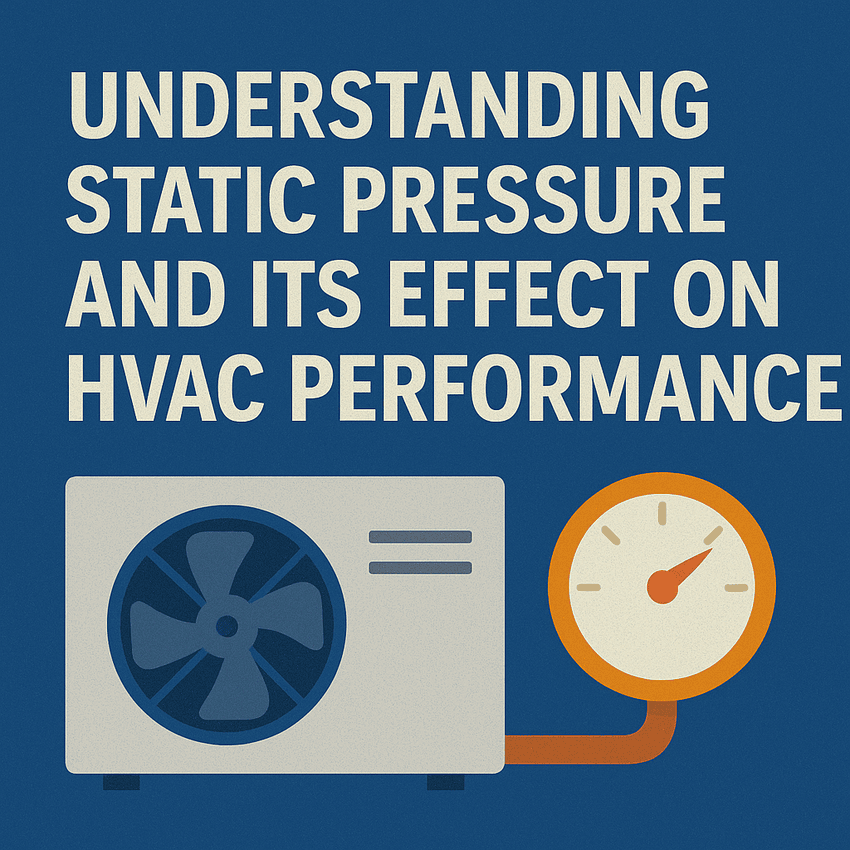What is Static Pressure in HVAC Systems?
Static pressure is the resistance to airflow in a heating, ventilation, and air conditioning (HVAC) system’s ductwork. It’s similar to blood pressure in the human body—too high or too low, and the system becomes inefficient. Static pressure is typically measured in inches of water column (in. WC) and helps determine how well air is being pushed through the duct system.
Maintaining optimal static pressure is vital because it directly impacts the comfort level, energy efficiency, and lifespan of HVAC components. Poor static pressure leads to noisy ducts, uneven temperatures, system stress, and higher utility bills.
Types of Static Pressure: Positive vs. Negative
There are two primary forms of static pressure in HVAC systems:
- Positive Static Pressure: Occurs on the supply side of the air handler, where the system pushes conditioned air into the space.
- Negative Static Pressure: Happens on the return side, where the system pulls air back into the unit.
To calculate total external static pressure (TESP), both values are added together. This total indicates the amount of resistance the blower motor is working against.
Ideal Static Pressure Ranges
A typical residential HVAC system should have a total external static pressure of 0.5 in. WC or lower. Here’s a breakdown:
| HVAC Component | Ideal Static Pressure Range (in. WC) |
| Total External | 0.5 or less |
| Supply Ductwork | 0.25 – 0.3 |
| Return Ductwork | 0.2 – 0.25 |
| Filter/Grill | 0.1 – 0.2 |
Values above these ranges indicate restrictions that could affect performance.
Why Static Pressure Matters to HVAC Performance
1. Affects Airflow and Comfort
High static pressure restricts airflow, leading to:
- Uneven room temperatures
- Weak airflow from vents
- Longer run times to maintain set temperatures
Low airflow prevents rooms from reaching desired heating or cooling levels, leading to discomfort.
2. Increases Energy Consumption
When static pressure rises, the blower motor works harder. This increases the amperage draw, causing your utility bills to spike. Over time, the added stress leads to motor burnout and system inefficiency.
3. Reduces Equipment Lifespan
Excessive pressure strains vital components like the:
- Blower motor
- Compressor
- Heat exchanger
- Cooling coil
This can cause early failures and frequent breakdowns—especially in undersized or poorly designed duct systems.
4. Promotes Excess Noise
Systems with high static pressure often become noisy. You may hear:
- Whistling through vents
- Buzzing or humming from the air handler
- Vibration sounds in ductwork
These noises indicate that the air is struggling to move through the system, often due to duct blockages, improper sizing, or dirty filters.
Common Causes of High Static Pressure
1. Dirty or Restrictive Filters
Using pleated filters with high MERV ratings can restrict airflow if not properly selected. A clogged filter is one of the most common causes of high static pressure.
2. Undersized or Poorly Designed Ductwork
Ducts that are too small or improperly laid out choke airflow and create resistance. This includes long duct runs, multiple sharp turns, or unnecessary branch-offs.
3. Closed or Blocked Vents
Blocked vents increase pressure in the duct system. Closing off too many supply registers can create backpressure and lower system efficiency.
4. Dirty Coils and Blower Wheels
Evaporator coils or blower wheels caked with dust and debris reduce the system’s ability to push air effectively, raising static pressure.
5. Inadequate Return Air Pathways
A restricted return forces the blower to work harder to pull air back into the system. This often happens in systems with limited return grills or where doors are kept closed.
How to Measure Static Pressure
Static pressure is measured using a manometer or a digital pressure gauge. Technicians place probes before and after the air handler:
- One in the supply plenum
- One in the return plenum
The total external static pressure is then calculated:
TESP = Supply Static Pressure + Return Static Pressure
If the result exceeds the manufacturer’s recommended range, corrective action is needed.
Steps to Reduce High Static Pressure
1. Replace Air Filters Regularly
Choose a filter that balances air cleanliness and airflow. Avoid overly restrictive filters unless necessary.
2. Resize or Redesign Ducts
An HVAC professional should evaluate duct sizing. Larger, properly insulated ducts ensure smoother airflow and reduce resistance.
3. Add More Return Vents
Adding additional return pathways or upgrading return grilles helps balance airflow and reduce suction strain.
4. Clean Blower and Coils
Routine maintenance ensures no obstructions affect airflow. Cleanings should be done annually or more often if needed.
5. Use ECM Motors
Upgrading to an Electronically Commutated Motor (ECM) allows variable speeds and better adaptation to pressure changes, improving energy efficiency.
6. Balance the System
An airflow balancing process ensures each room receives the right amount of conditioned air. This can involve dampers, duct modifications, or zoning.
The Role of Static Pressure in HVAC Diagnostics
Understanding static pressure is essential for accurate HVAC diagnostics. If a system is underperforming, checking static pressure provides insight into:
- Whether airflow is adequate
- If the blower motor is overworked
- Whether ducts or filters are causing resistance
- If equipment is operating within safe parameters
Monitoring static pressure also helps in evaluating system upgrades, like adding zones or replacing old ductwork. It’s a foundational step in system commissioning and seasonal tune-ups.
Conclusion: Monitor Static Pressure to Maximize Performance
Static pressure isn’t just a number—it’s a key performance indicator for your HVAC system. Left unchecked, it can wreak havoc on efficiency, comfort, and equipment health. By proactively measuring and adjusting static pressure, we ensure our clients enjoy optimized airflow, lower utility costs, quieter operation, and longer-lasting equipment.
If you suspect your HVAC system isn’t performing at its best, contact a certified HVAC professional to evaluate your static pressure and ductwork design. Investing in diagnostics today can prevent costly repairs and energy waste tomorrow.


